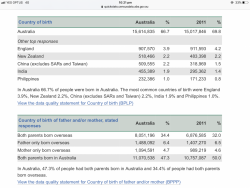Melburnian1
Veteran Member
- Joined
- Jun 7, 2013
- Posts
- 25,486
The June 2019 international airline activity figures were released by BITRE on Monday 2 September 2019:
Overall, passenger numbers for June 2019 (compared to June 2018) only rose 1.6 per cent (compared to the annual rise of 3.7 per cent), so the slowdown in mainland Chinese tourism is really starting to bit. (Separately, MEL has already reported that both its domestic and international passenger numbers declined in July 2019.)
The biggest surprise for the month was that compared to June 2018, SQ has increased its share of passengers from 8.3 to 9 per cent. EK dropped from 8 per cent to 7.2, not a surprise, while QF marginally rose from 17.3 to 17.5 per cent, but stablemate JQ fell, from 8.7 to 8.5 per cent.
Reflecting its newish SYD - HKG route, VA's share of passengers arriving from or departing to overseas rose from 5.8 to 6.6 per cent, although like some other airlines this has not translated into profits.
LCCs had a drop in their share from 15.1 to 14.2 per cent. This may largely reflect how D7 reduced some frequencies if I recall.
There was more than a 10 per cent drop in freight carried by international airlines in June 2019 compared to June 2018. While of little interest to passengers, it indicates a slowing consumer economy given that low value products are typically not carried by air. The airlines would regret the loss in revenue.
The most popular route, MEL - SIN, showed a mammoth 12.2 per cent increase in passenger numbers in 2018-19 that ties in with SQ's market share increase.
Routes to and from AKL in most cases performed poorly. The UAE had a three per cent drop in passenger numbers ex/to Oz, unsurprising given the QF abandonment of own metal flights to or from DXB.
Despite much publicity from those who don't like President Trump that USA tourist arrivals are depressed, passengers on the USA routes increased by 3.5 per cent although that figure doesn't tell us from which originating end any growth was.
'Other countries' apart from the 'top 10' continued to grow a lot more strongly. One example was the MEL - MNL route where passenger numbers basically doubled in June 2019 compared to June 2018 thanks to LCC 5J's entry.
Mattg's favourite airline - just kidding - in Donghai Airlines (DRW - SZX route) only carried a total of 533 passengers in June 2019, down from 720 in June 2018. Yet IIRC it has increased its frequencies on this odd route.
VA's load factors of 60 to 74 per cent on its HKG routes were well below CX and QF. Partly this is an unfair comparison as the SYD VA oute has not long been established and probably needs 12 months to gain higher consumer awareness.
QF passenger numbers (own metal) to and from Indonesia skyrocketed more than 95 per cent, comparing the two Junes, that we can put down to the introduction of the daily QF43 A332 from SYD and B738 on QF45 from MEL. Garuda's numbers to Indonesia dropped 6.2 per cent, but JQ's rose five per cent. I don't know if there's a nexus between the three. I've not travelled on GA but its safety problems of years ago seem to have been consigned to the history dustbin. Does it price itself above JQ and have the additional difficulty that many potential travellers to Bali or jakarta don't know a lot about it, or assume (wrongly) it's still unsafe? It receives pretty good reviews online.
OOL had almost a 10 per cent drop in international passengers in the year to 30 June 2019. Again, wasn't this largely because D7 reduced its flight frequencies? Music in the ear to BNE's Dutch owners.
Strangely, Batik Air and increasingly prominent Malindo Air did not carry any freight to or from Oz. Is this because they have made a conscious decision not to, or does it reflect limited B738 hold space or lack of cargo agents?
Reflecting abandonment of some flights, CA had almost a 30 per cent drop in passengers. Conversely, MU had a 32.9 per cent rise.
Given D7's passenger numbers, at face value its move to AVV has been a success (although I don't know if yields are satisfactory.) 10 or so days ago, Linfox Group signed an agreement with the company behind Vietnam's fastest growing airline VietJet so it too at some stage looks to be bound for Geelong.
AI had very good load factors of 85 to 90 per cent in June 2019, which begs the question: despite it allegedly being low yielding, why aren't other airlines considering nonstop flights between Australia and India, which in not too many years will be the world's most populous nation? We have c.500,000 Indians in Australia who are citizens or permanent residents yet this market attracts little attention from government, in comparison to the huge amount of time spent nurturing the admittedly high spending mainland communist Chinese market.
With the A$ at US 67 cents today, muted consumer spending and declining interest from mainland Chinese (who have their own economic problems), it's possible that 2019-20 will see an overall drop in international airline passenger figures to and from Oz.
Overall, passenger numbers for June 2019 (compared to June 2018) only rose 1.6 per cent (compared to the annual rise of 3.7 per cent), so the slowdown in mainland Chinese tourism is really starting to bit. (Separately, MEL has already reported that both its domestic and international passenger numbers declined in July 2019.)
The biggest surprise for the month was that compared to June 2018, SQ has increased its share of passengers from 8.3 to 9 per cent. EK dropped from 8 per cent to 7.2, not a surprise, while QF marginally rose from 17.3 to 17.5 per cent, but stablemate JQ fell, from 8.7 to 8.5 per cent.
Reflecting its newish SYD - HKG route, VA's share of passengers arriving from or departing to overseas rose from 5.8 to 6.6 per cent, although like some other airlines this has not translated into profits.
LCCs had a drop in their share from 15.1 to 14.2 per cent. This may largely reflect how D7 reduced some frequencies if I recall.
There was more than a 10 per cent drop in freight carried by international airlines in June 2019 compared to June 2018. While of little interest to passengers, it indicates a slowing consumer economy given that low value products are typically not carried by air. The airlines would regret the loss in revenue.
The most popular route, MEL - SIN, showed a mammoth 12.2 per cent increase in passenger numbers in 2018-19 that ties in with SQ's market share increase.
Routes to and from AKL in most cases performed poorly. The UAE had a three per cent drop in passenger numbers ex/to Oz, unsurprising given the QF abandonment of own metal flights to or from DXB.
Despite much publicity from those who don't like President Trump that USA tourist arrivals are depressed, passengers on the USA routes increased by 3.5 per cent although that figure doesn't tell us from which originating end any growth was.
'Other countries' apart from the 'top 10' continued to grow a lot more strongly. One example was the MEL - MNL route where passenger numbers basically doubled in June 2019 compared to June 2018 thanks to LCC 5J's entry.
Mattg's favourite airline - just kidding - in Donghai Airlines (DRW - SZX route) only carried a total of 533 passengers in June 2019, down from 720 in June 2018. Yet IIRC it has increased its frequencies on this odd route.
VA's load factors of 60 to 74 per cent on its HKG routes were well below CX and QF. Partly this is an unfair comparison as the SYD VA oute has not long been established and probably needs 12 months to gain higher consumer awareness.
QF passenger numbers (own metal) to and from Indonesia skyrocketed more than 95 per cent, comparing the two Junes, that we can put down to the introduction of the daily QF43 A332 from SYD and B738 on QF45 from MEL. Garuda's numbers to Indonesia dropped 6.2 per cent, but JQ's rose five per cent. I don't know if there's a nexus between the three. I've not travelled on GA but its safety problems of years ago seem to have been consigned to the history dustbin. Does it price itself above JQ and have the additional difficulty that many potential travellers to Bali or jakarta don't know a lot about it, or assume (wrongly) it's still unsafe? It receives pretty good reviews online.
OOL had almost a 10 per cent drop in international passengers in the year to 30 June 2019. Again, wasn't this largely because D7 reduced its flight frequencies? Music in the ear to BNE's Dutch owners.
Strangely, Batik Air and increasingly prominent Malindo Air did not carry any freight to or from Oz. Is this because they have made a conscious decision not to, or does it reflect limited B738 hold space or lack of cargo agents?
Reflecting abandonment of some flights, CA had almost a 30 per cent drop in passengers. Conversely, MU had a 32.9 per cent rise.
Given D7's passenger numbers, at face value its move to AVV has been a success (although I don't know if yields are satisfactory.) 10 or so days ago, Linfox Group signed an agreement with the company behind Vietnam's fastest growing airline VietJet so it too at some stage looks to be bound for Geelong.
AI had very good load factors of 85 to 90 per cent in June 2019, which begs the question: despite it allegedly being low yielding, why aren't other airlines considering nonstop flights between Australia and India, which in not too many years will be the world's most populous nation? We have c.500,000 Indians in Australia who are citizens or permanent residents yet this market attracts little attention from government, in comparison to the huge amount of time spent nurturing the admittedly high spending mainland communist Chinese market.
With the A$ at US 67 cents today, muted consumer spending and declining interest from mainland Chinese (who have their own economic problems), it's possible that 2019-20 will see an overall drop in international airline passenger figures to and from Oz.
Last edited:


















